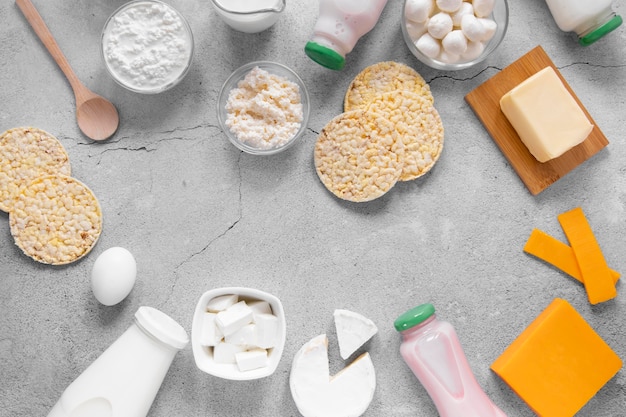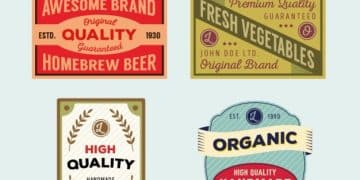New Food Labeling Regulations: Your Guide to Added Sugars & Artificial Ingredients

New regulations on food labeling mandate clearer information about added sugars and artificial ingredients, empowering consumers to make informed choices and promoting healthier eating habits by enhancing transparency in the food industry.
Are you aware of the recent changes to food labels? The **new regulations on food labeling** are designed to provide consumers with a clearer understanding of what they’re eating, particularly when it comes to added sugars and artificial ingredients. Let’s delve into what these changes entail and how they can impact your dietary choices.
Why the Change in Food Labeling Regulations?
The updates to food labeling regulations didn’t happen overnight. They are a response to growing concerns about public health, particularly the rise in obesity and related diseases. Understanding why these changes were implemented is crucial to appreciating their significance.
For years, consumers have struggled to decipher the complex information on food labels. The old system often obscured the presence of added sugars and artificial ingredients, making it difficult for people to make informed decisions about their diets. The new regulations aim to rectify this by enhancing transparency and clarity.
The Push for Transparency
One of the main drivers behind the new regulations is the demand for greater transparency in the food industry. Consumers want to know exactly what they’re putting into their bodies, and they have a right to access this information easily.
Addressing Public Health Concerns
Another key reason for the changes is to address pressing public health concerns. High consumption of added sugars and artificial ingredients has been linked to a range of health problems, including obesity, type 2 diabetes, and heart disease. By providing clearer information about these substances, the regulations hope to encourage healthier eating habits.
- Empowering Consumers: Clearer labels enable informed choices.
- Promoting Healthier Diets: Highlighting added sugars encourages moderation.
- Holding Manufacturers Accountable: Transparency fosters responsible food production.
Ultimately, the changes in food labeling regulations reflect a broader effort to improve public health by empowering consumers with the knowledge they need to make better dietary choices. By providing clearer and more accessible information, the regulations aim to create a more transparent and accountable food system.

Decoding the New Nutrition Facts Label
The Nutrition Facts label has undergone a significant makeover. The new design incorporates several key changes that make it easier for consumers to understand the nutritional content of their food. Here’s a breakdown of the most important updates.
One of the most noticeable changes is the increased prominence of serving sizes. Recognizing that people often consume more than the recommended serving, the new labels reflect portion sizes that more closely resemble what people actually eat.
Highlighting Serving Sizes
The updated labels feature larger and bolder typefaces for serving sizes and calories, making them easier to spot at a glance. This change is particularly helpful for individuals who are trying to manage their weight or calorie intake.
Added Sugars Are Now Listed
Perhaps the most significant change is the inclusion of a separate line for added sugars. Previously, total sugars were listed without differentiating between naturally occurring sugars (like those in fruit) and added sugars (like those in processed foods). The new label clearly indicates the amount of added sugars in grams and as a percentage of the Daily Value.
- Calories: Displayed in a larger, bolder font for emphasis.
- Serving Sizes: Updated to reflect realistic consumption patterns.
- Added Sugars: Listed separately to distinguish from natural sugars.
Understanding these changes is essential for navigating the updated Nutrition Facts label effectively. By paying attention to serving sizes, calories, and added sugars, consumers can make more informed decisions about their food choices and better manage their overall health.
Spotting Artificial Ingredients: A Guide
Artificial ingredients are synthetic substances added to foods to enhance flavor, color, texture, or shelf life. Identifying these ingredients can be challenging, as they often go by unfamiliar names. Here’s a guide to help you spot them on food labels.
Artificial sweeteners are a common type of artificial ingredient found in many processed foods and beverages. These sweeteners, such as aspartame, sucralose, and saccharin, are used to reduce the sugar content of products while maintaining a sweet taste.
Common Artificial Sweeteners
Aspartame, sucralose, and saccharin are some of the most widely used artificial sweeteners. They are often found in diet sodas, sugar-free candies, and other low-calorie products. While they may seem like a healthier alternative to sugar, some studies have raised concerns about their potential health effects.
Artificial Colors and Flavors
Artificial colors and flavors are added to foods to make them more visually appealing and palatable. These ingredients are often derived from petroleum or other synthetic sources. Common artificial colors include FD&C Red No. 40, FD&C Yellow No. 5, and FD&C Blue No. 1. Artificial flavors can be more difficult to identify, as they are often listed simply as “artificial flavors” without specifying the exact chemical compounds used.
- Read the Ingredient List: Look for unfamiliar chemical names.
- Be Aware of Common Additives: Learn to recognize artificial sweeteners and colors.
- Choose Whole Foods: Minimize processed foods to limit exposure to artificial ingredients.
Being able to identify artificial ingredients is a valuable skill for anyone looking to improve their diet. By reading labels carefully and opting for whole, unprocessed foods, you can reduce your exposure to these synthetic substances and prioritize your health.
The Impact on Food Manufacturers
The new regulations on food labeling have far-reaching implications for food manufacturers. Companies are now required to reformulate their products and update their labeling practices to comply with the new standards. This process can be costly and time-consuming, but it also presents an opportunity for innovation.
One of the biggest challenges for food manufacturers is reformulating products to reduce the amount of added sugars. This can be particularly difficult for foods that rely on sugar for flavor, texture, or preservation.
Reformulation Challenges
Reducing added sugars often requires manufacturers to experiment with alternative sweeteners, such as stevia or monk fruit. However, these sweeteners can have different flavor profiles and may not replicate the taste or texture of sugar perfectly. Manufacturers must also consider the impact of reformulation on the overall cost and shelf life of their products.
Labeling Changes and Compliance
In addition to reformulating products, food manufacturers must also update their labels to comply with the new regulations. This involves calculating the amount of added sugars in each product and listing it separately on the Nutrition Facts label. Manufacturers must also ensure that their serving sizes are accurate and reflect realistic consumption patterns.

- R&D Investment: Companies must invest in research and development to find sugar alternatives.
- Supply Chain Adjustments: Sourcing new ingredients can impact supply chains.
- Consumer Communication: Educating consumers about product changes is crucial.
The new regulations on food labeling create both challenges and opportunities for food manufacturers. While compliance may require significant investment and effort, it also encourages companies to innovate and create healthier, more transparent products that meet the evolving needs of consumers.
Consumer Behaviour and Healthier Choices
The ultimate goal of the new regulations on food labeling is to influence consumer behavior and promote healthier choices. By providing clearer and more accessible information about added sugars and artificial ingredients, the regulations aim to empower individuals to make better dietary decisions.
One of the key ways the regulations can impact consumer behavior is by raising awareness of the amount of added sugars in processed foods. Many people are unaware of how much added sugar they consume each day, and the new labels can serve as a wake-up call.
Raising Awareness
The prominence of added sugars on the Nutrition Facts label is designed to grab consumers’ attention and make them think twice about their food choices. By seeing the amount of added sugar in grams and as a percentage of the Daily Value, consumers can better understand the potential health implications of their consumption habits.
Encouraging Informed Decisions
In addition to raising awareness, the new regulations also aim to empower consumers to make more informed decisions. By providing clear and accurate information about added sugars and artificial ingredients, the labels enable individuals to compare products and choose those that align with their health goals.
- Increased Scrutiny: Consumers are more likely to examine labels closely.
- Product Comparison: Easier to compare products based on sugar content.
- Demand for Healthier Options: Consumer demand may drive manufacturers to create healthier products.
The new regulations on food labeling have the potential to significantly impact consumer behavior and promote healthier choices. By providing clearer and more accessible information, the labels empower individuals to take control of their diets and make more informed decisions about their health.
Future Trends in Food Labeling
As consumer awareness and technology continue to evolve, the future of food labeling is likely to bring even more innovative and informative approaches. From digital labels to personalized nutrition information, several exciting trends are on the horizon.
One emerging trend is the use of digital labels that can be accessed via smartphones or other devices. These labels can provide a wealth of additional information, such as detailed nutritional profiles, allergen information, and even personalized dietary recommendations.
Digital Labels and QR Codes
Digital labels often use QR codes that can be scanned with a smartphone to access a product’s website or a dedicated app. This allows manufacturers to provide much more information than can fit on a traditional printed label, and it also makes it easier to update information as needed.
Personalized Nutrition Information
Another promising trend is the use of personalized nutrition information. Advances in data science and technology are making it possible to tailor dietary recommendations to an individual’s unique needs and preferences. Food labels of the future may provide personalized information based on a person’s health status, lifestyle, and genetic predispositions.
- Interactive Labels: QR codes link to detailed product information.
- Smartphone Apps: Apps provide personalized dietary recommendations.
- Transparency: Blockchain technology tracks food from farm to table.
The future of food labeling is likely to be characterized by greater interactivity, personalization, and transparency. As technology continues to advance, consumers will have access to more information than ever before, empowering them to make even more informed choices about their diets and health.
| Key Point | Brief Description |
|---|---|
| ✅ Added Sugars Listed | New labels show added sugars to improve transparency. |
| 🧪 Artificial Ingredients | Spot artificial colors, flavors, and sweeteners. |
| ⚖️ Serving Sizes Updated | Reflects real-world consumption habits. |
| 📱 Future: Digital Labels | Interactive labels offer expanded info. |
Frequently Asked Questions
▼
Listing added sugars separately helps consumers distinguish between naturally occurring sugars and those added during processing, aiding healthier choices.
▼
Look for unfamiliar chemical names like FD&C Red No. 40 or aspartame in the ingredient list to identify artificial ingredients.
▼
Food manufacturers must reformulate products and update labels, which requires investment in research and development and supply chain adjustments.
▼
Updated serving sizes reflect actual consumption, helping consumers make more informed decisions about calorie and nutrient intake.
▼
Future trends include digital labels with QR codes for expanded information and personalized nutrition recommendations based on individual health profiles.
Conclusion
The new regulations on food labeling represent a significant step forward in empowering consumers to make informed choices about their diets. By providing clearer and more accessible information about added sugars and artificial ingredients, these regulations have the potential to promote healthier eating habits and improve public health outcomes. As technology continues to evolve, the future of food labeling is likely to bring even more innovative and personalized approaches, further enhancing transparency and empowering consumers to take control of their health.





